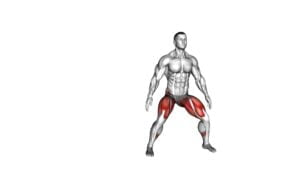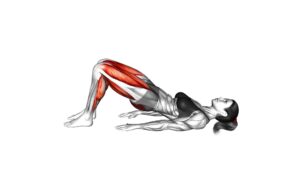Side Walk Squat (female) – Video Exercise Guide & Tips

Are you looking for an effective exercise to tone your lower body? Look no further than the side walk squat!
Watch This Exercise Video
This video exercise guide and tips will show you how to properly perform the side walk squat, targeting your glutes, quads, and hamstrings.
With variations and progressions to challenge yourself, you can easily incorporate this exercise into your workout routine.
Get ready to feel the burn and achieve those fitness goals!
Key Takeaways
- Side Walk Squats are beneficial for women as they increase strength, improve mobility, and enhance lower body strength and stability.
- Proper form and technique for Side Walk Squats include standing with feet hip-width apart, keeping the back straight, engaging core muscles, and pushing through the heels to rise back up.
- Side Walk Squats require no equipment and can be done in a flat, open space, making them convenient and accessible for women.
- Variations and progressions of Side Walk Squats include adding resistance with dumbbells or kettlebells, performing single-leg Side Walk Squats, increasing speed for cardiovascular endurance, and lowering hips further to increase difficulty.
Benefits of Side Walk Squat for Women
You'll experience increased strength and improved mobility with the Side Walk Squat exercise for women. This exercise offers numerous benefits, including improving balance and targeting the inner thigh muscles.
One of the key benefits of the Side Walk Squat is its ability to enhance balance. As you perform the exercise, you'll engage your core muscles to stabilize your body. This not only strengthens your core, but also helps improve your balance over time. This is especially beneficial for women, as they often have a higher risk of balance-related issues compared to men.
Additionally, the Side Walk Squat specifically targets the inner thigh muscles, also known as the adductors. These muscles play a crucial role in movements such as walking, running, and jumping. By strengthening the inner thigh muscles, you can enhance your overall lower body strength and stability. This can be particularly helpful for women, as they tend to have a greater tendency for knee instability.
Proper Form and Technique for Side Walk Squat
To perform the Side Walk Squat exercise with proper form and technique, focus on maintaining a stable core and engaging the inner thigh muscles. This won't only maximize the effectiveness of the exercise but also help in preventing injuries. Here are some tips to ensure you perform the Side Walk Squat correctly:
- Stand with your feet hip-width apart and toes pointing forward.
- Keep your back straight and shoulders down, avoiding any rounding or hunching.
- Engage your core by pulling your belly button towards your spine.
- Begin the movement by bending your knees and lowering your hips down into a squat position.
- As you squat, make sure to keep your knees aligned with your toes and avoid letting them collapse inward.
- Push through your heels to rise back up to the starting position.
- To engage your inner thigh muscles, focus on squeezing your legs together as you push up from the squat.
By following these proper form and technique cues, you can perform the Side Walk Squat safely and effectively. For beginners, it's recommended to start with a modified version by using a chair or wall for support until you build enough strength and stability. This modification will help you maintain proper form and reduce the risk of injury.
Now that you know how to perform the Side Walk Squat with proper form and technique, let's move on to the next section and discuss the equipment needed for this exercise.
Equipment Needed for Side Walk Squat
You often need minimal equipment for the Side Walk Squat exercise. This makes it a convenient and accessible exercise to incorporate into your workout routine. To perform the Side Walk Squat, all you need is a flat, open space. No additional equipment such as dumbbells, resistance bands, or exercise machines are necessary. This simplicity makes it a great exercise for those who prefer bodyweight exercises or who may not have access to gym equipment.
Not requiring any equipment also means that the Side Walk Squat is a low-impact exercise, making it ideal for individuals looking to prevent knee pain or those recovering from knee injuries. By focusing on proper form and technique, you can engage your glutes, hamstrings, and quadriceps while minimizing stress on your knees.
Now that you know the equipment needed for the Side Walk Squat, let's move on to exploring the variations and progressions of this exercise. By incorporating different variations, you can further challenge your muscles and continue to improve your strength and stability.
Variations and Progressions of Side Walk Squat
To challenge your muscles and further improve your strength and stability, try incorporating different variations and progressions of the Side Walk Squat exercise. By modifying the Side Walk Squat, you can add variety to your workout routine and target specific muscle groups.
Here are two sub-lists of modifications and challenges you can try:
Modifications:
- Add resistance: Hold a dumbbell or kettlebell at your chest or sides to increase the intensity of the exercise.
- Single-leg Side Walk Squat: Perform the exercise while balancing on one leg, alternating sides.
Challenges:
- Speed: Increase the pace of your Side Walk Squats to challenge your cardiovascular endurance.
- Depth: Lower your hips further towards the ground to increase the difficulty and engage your leg muscles more.
By incorporating these modifications and challenges, you can continuously progress and keep your workouts interesting. Remember to focus on maintaining proper form and control throughout the exercise. This will help prevent injury and ensure that you're effectively targeting the right muscles.
Now let's move on to the next section, where we'll discuss common mistakes to avoid during the Side Walk Squat.
Common Mistakes to Avoid During Side Walk Squat
When performing the side walk squat, it's important to pay attention to proper form to maximize effectiveness and prevent injury.
One common mistake to avoid is letting your knees cave inwards during the squat. To prevent this, focus on pushing your knees outwards and maintaining alignment with your toes.
This will help to engage the correct muscles and protect your knees from unnecessary strain.
Proper Form Tips
How can you ensure proper form during the Side Walk Squat exercise to avoid common mistakes? Proper form is crucial to prevent injuries and maximize the effectiveness of this exercise. Here are some tips to help you maintain proper form:
- Keep your feet shoulder-width apart and toes pointing forward.
- Engage your core and maintain a straight back throughout the exercise.
- Bend your knees and lower your body into a squat position, making sure your knees don't extend past your toes.
- As you squat, push your hips back and keep your weight on your heels.
- Take small steps sideways, maintaining the squat position, and keeping your knees bent.
- To modify the exercise for beginners, start with a shallower squat and take smaller steps.
Preventing Knee Pain
Maintain proper knee alignment to prevent pain during the Side Walk Squat exercise. Avoiding knee injuries is crucial when performing this movement.
One common mistake to avoid is allowing your knees to collapse inward. This puts excessive stress on the knee joint and can lead to pain or injury. Instead, focus on keeping your knees in line with your toes throughout the entire exercise.
Strengthening leg muscles can also help prevent knee pain. Strong quadriceps and glutes provide stability to the knee joint and reduce the risk of injury. Incorporate exercises like squats and lunges into your workout routine to target these muscles.
Tips for Incorporating Side Walk Squat Into Your Workout Routine
To incorporate Side Walk Squat into your workout routine, begin by selecting a suitable location. This exercise requires a flat surface with enough space for you to step sideways. Once you have found the right spot, follow these tips to maximize the benefits of Side Walk Squat:
- Start with a proper warm-up: Before incorporating Side Walk Squat into your workout, warm up your muscles with some light cardio exercises like jogging or jumping jacks. This will prepare your body for the upcoming workout.
- Incorporate Side Walk Squat into cardio workouts: To make the most out of this exercise, try adding it into your cardio routine. Perform a set of Side Walk Squats followed by a high-intensity cardio exercise like jumping rope or burpees. This combination will help improve your cardiovascular endurance while targeting your lower body muscles.
Modifications for beginners in Side Walk Squat:
- Use a chair for support: If you find it challenging to maintain balance during Side Walk Squat, use a chair for support. Place the chair next to you and lightly hold onto it as you perform the exercise. This will help you stabilize yourself and gradually build strength in your legs.
- Reduce the range of motion: If you're new to Side Walk Squat, start by performing a partial squat instead of going all the way down. This modification will make the exercise more manageable and allow you to focus on maintaining proper form.
Frequently Asked Questions
How Many Calories Does the Side Walk Squat Exercise Burn?
The side walk squat exercise is a great way to burn calories and improve your fitness. It's a lower body exercise that targets your glutes, quads, and hamstrings. By incorporating this exercise into your routine, you can increase your caloric expenditure and promote weight loss.
While the video guide focuses on the female version of the exercise, it's important to note that the benefits of side walk squats apply to both men and women.
Can Men Also Benefit From Doing the Side Walk Squat?
Yes, men can definitely benefit from doing the side walk squat exercise. Men's fitness can be enhanced through this exercise as it targets multiple muscle groups, including the glutes, quads, and hamstrings.
Side walk squats help to improve strength, stability, and overall lower body power, which are essential for activities like running, jumping, and lifting.
How Long Should I Rest Between Sets of Side Walk Squats?
When it comes to the side walk squat, it's important to know how long you should rest between sets. Rest time plays a crucial role in allowing your muscles to recover and grow stronger.
It's recommended to rest for about 30-60 seconds between sets of side walk squats. However, keep in mind that the exact rest time may vary depending on your fitness level and goals.
Additionally, make sure to maintain proper form throughout the exercise to avoid any injuries.
Are There Any Modifications for Individuals With Knee or Hip Issues?
If you have knee or hip issues, there are modifications you can make to the side walk squat exercise. Some modifications include reducing the depth of the squat, using a chair or wall for support, or performing a different exercise altogether.
It's important to prioritize your safety and avoid aggravating any existing injuries. Proper form is crucial for side walk squats, so be sure to consult with a fitness professional or physical therapist for guidance specific to your needs.
Can the Side Walk Squat Be Done Without Any Equipment?
Yes, you can definitely do the side walk squat without any equipment. It's a bodyweight exercise that primarily targets your lower body muscles, including your quadriceps, hamstrings, and glutes.
The side walk squat is a great exercise for improving lower body strength, stability, and mobility.
You can also modify the exercise by incorporating variations such as adding a resistance band or performing it on an unstable surface to further challenge your muscles and improve balance.
Conclusion
Incorporating side walk squats into your workout routine can be a great way for women to strengthen their lower body and improve balance. By following proper form and technique, using the necessary equipment, and avoiding common mistakes, you can maximize the benefits of this exercise.
Whether you're a beginner or advanced, there are variations and progressions to suit your fitness level.
So, give side walk squats a try and enhance your overall fitness and physique.

Author
Years ago, the spark of my life’s passion ignited in my mind the moment I stepped into the local gym for the first time. The inaugural bead of perspiration, the initial endeavor, the very first surge of endorphins, and a sense of pride that washed over me post-workout marked the beginning of my deep-seated interest in strength sports, fitness, and sports nutrition. This very curiosity blossomed rapidly into a profound fascination, propelling me to earn a Master’s degree in Physical Education from the Academy of Physical Education in Krakow, followed by a Sports Manager diploma from the Jagiellonian University. My journey of growth led me to gain more specialized qualifications, such as being a certified personal trainer with a focus on sports dietetics, a lifeguard, and an instructor for wellness and corrective gymnastics. Theoretical knowledge paired seamlessly with practical experience, reinforcing my belief that the transformation of individuals under my guidance was also a reflection of my personal growth. This belief holds true even today. Each day, I strive to push the boundaries and explore new realms. These realms gently elevate me to greater heights. The unique combination of passion for my field and the continuous quest for growth fuels my drive to break new ground.



